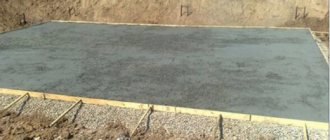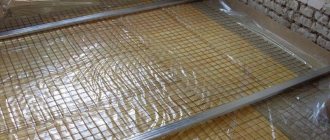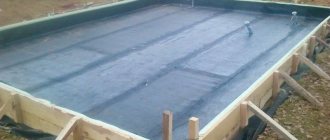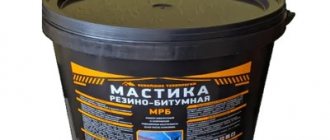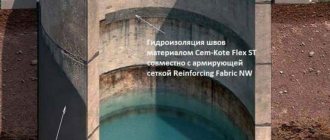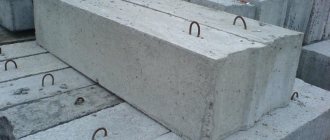Bitumen mastic is a homogeneous plastic substance made on the basis of bitumen and various additives that improve its properties. It has excellent physical and chemical properties, which make it an ideal waterproofing and adhesive material. After application to the surface, the mastic quickly hardens.
What is bitumen waterproofing, its advantages and disadvantages
Bituminous waterproofing is a homogeneous thick mass of bitumen and various additives. This material is designed to protect buildings and their elements from the harmful effects of the environment. The material is made on the basis of organic or synthetic resin with the addition of various substances, such as resins, oxidizing agents, asphaltenes, carboids, etc. High-quality bitumen-based mastic contains reinforcing fibers that prevent cracks due to temperature changes. Most often, bitumen waterproofing is represented by black coating mastic. This building material is very elastic and with its help a waterproof layer is created on the surfaces of buildings.
Bitumen compositions differ from each other by the presence of various additives in the form of improving polymers, which help the formed bitumen coating to be more elastic and resistant to heat or frost.
Advantages:
- The price of bitumen waterproofing is lower than other building materials that protect structures from moisture.
- After applying this material, no visible seams remain; the waterproofing covers the surface with an even layer without microcracks and holes.
- Bitumen waterproofing is easy to work with, regardless of where it is used.
- The material is universal, it can be used for completely different purposes. It is usually used when laying a foundation, but it is also perfect for waterproofing basements, walls, blind areas and other buried structures.
- High-quality waterproofing is characterized by high elasticity and strength, ensuring the durability of the coating. During operation, the material does not crack, which ensures complete waterproofness of the building.
- Bitumen waterproofing has a low density, which makes it easy to transport due to its low weight relative to a given volume.
Flaws:
- Conventional mastic is always based on resin, which determines its main drawback - fragility. After only 2-5 years of use, it begins to dry out, harden and begin to crack. Typically, this property is characteristic of cheap bitumen mastic; expensive ones contain polymers and substance impurities that prevent cracks and rapid aging of the coating.
- The next disadvantage of mastic is also related to the characteristics of the resin. Whatever impurities are added to the waterproofing, the applied coating will be susceptible to environmental factors. Thus, high temperature, frost, salts and minerals in the input have a detrimental effect on cheap bitumen mastic.
- There is a high probability of such coating being repaired or completely replaced in 2-5 years.
- Due to the low cost of bitumen, this type of waterproofing is in high demand among contractors, which is why the quality of the insulating coating sometimes suffers. You should be attentive to the materials that builders use and do not forget the well-known proverb “Good things don’t come cheap.”
Important: When using cheap bitumen-based coating mastic, you may encounter the following: After curing, the mastic drains even when tilted at 30°; The composition dries for more than a week and still remains sticky; The coating needs to be renewed every year; The resulting base is toxic and has a terrible smell; If you want to apply a higher-quality composition, the existing one will have to be scraped off manually to zero; Lack of adhesion (cohesion) can lead to zero protective effect.
Where can it be used?
Various bitumen compositions intended for waterproofing can be used in the following structures:
- Foundation slabs
- Foundations
- Strip foundations
- FBS blocks and other blocks
- Walls
- Floors
- Floor slabs
- Roofs
- Underground parts of buildings and structures
- Blind areas
- Reservoirs
Bituminous coatings can also be applied to substrates made from:
- Concrete;
- Brick;
- Metal;
- Bitumen roll membranes;
- Bases and other bitumen-based waterproofing coatings.
Scope of application
Mastic is actively used for waterproofing foundations, manufacturing roofing structures, building slabs, and basements. The material is also used for treating sewer and water pipes. Some types of bitumen coating are suitable for installing parquet, linoleum and other polymer finishes.
The main types of work for which bitumen mastic is used:
- Waterproofing is the creation of a protective layer that prevents the destruction of the structure due to exposure to moisture and the development of corrosion processes. Main areas of application: foundation structures, reinforced concrete products, other materials installed underground. Mastic is also used to treat the undersides of vehicles.
- Bonding - the principle of operation of the material is similar to moisture-resistant glue. Therefore, it is used for fixing sand-lime bricks and tiles. Other areas of application: installation of roll roofing, roofing felt, PVC membranes. When performing local roof repairs, cracks are covered with mastic and patches made from bitumen shingles and other materials are glued on.
- Road construction - using hot mastic, road surfaces are laid, holes and depressions are filled. Bitumen is added to the asphalt mixture as a binder. This gives the road strength and durability.
Bitumen waterproofing of roof and foundation | Types of waterproofing | Secrets and tips from the pros
The popularity of bitumen mastic is due to its physical properties. High resistance to moisture and microbiological processes is especially valued. The material reliably protects the base from mold and mildew, premature destruction of the structure in conditions of high humidity.
The method of using mastic is simple; just use a roller or brush to distribute the composition over the working surface. It is also possible to carry out processing using the pouring method, which eliminates the formation of leaks during the operation of the structure.
Main classification of bitumen waterproofing:
Bitumen products are divided into several main types, the difference of which is mainly due to the method of their construction and application.
- hot
- Cold
Hot bitumen waterproofing
When working with hot bitumen, it must be heated in a bitumen cooker so that the mixture can be evenly spread or applied to the surface. The substance is applied to a clean surface without dust and dirt using brushes and rollers. A layer consisting of hot bitumen dries quickly and does not shrink when set. Despite the low cost of the material, the surface is seamless. When preparing the material, you should be careful; burns are a common occurrence in this matter. It is also possible that smoke may be released and soot may settle during preparatory measures. Quick drying can be a disadvantage of this type of composition, since you have to work quickly, otherwise the mass will become too viscous. In order to maintain hot bitumen in a liquid state, a special platform or special equipment is required. This type of coating quickly becomes viscous, and the transition to a solid and more durable state takes relatively longer. The use of this material is not economical; working with one cubic meter of surface requires a larger amount of mastic, about 2 kg.
Important: When preparing for work with hot bitumen, as well as when performing the work itself, it is necessary to follow safety and labor protection requirements, otherwise such work may result in burns, severe injuries and death both for the work operator himself and for those around him of people.
Cold bitumen waterproofing
Cold bitumen waterproofing is called mastic, which does not need to be heated before use.
Cold formulations are divided into 2 types:
- Solvent-based - Before use, just add a little solvent and the composition is ready for use.
- Water-based (so-called emulsions) – These coatings are more environmentally friendly and less flammable, which is why they are more often used for work in residential areas, such as basements, basement walls and floors.
In general, the advantages of cold bitumen over hot bitumen are:
- Cold bitumen does not require much time to prepare;
- Materials of this kind are characterized by adhesion to all types of surfaces, in addition, they are very plastic and elastic, which makes the process of working with them much easier and more enjoyable;
- The compositions harden quickly, but do not quickly become so thick that they are difficult to work with;
- Such materials are more mechanically strong and also better withstand temperature changes, that is, generally more reliable and durable.
One of the main disadvantages of this kind of mastics compared to hot ones is their higher cost.
Comparison table between cold and hot mastics
| Characteristics | Cold with solvents | Cold water based | hot |
| Layer thickness in mm | 0,5-1 | 0,5-1 | 1,5-2 |
| Consumption kg\m2 for 1 layer device | 1-2 | 1-1,5 | 2-3 |
| Drying time at a temperature of +15C and above in hours | 12-24 | 3-6 | 2-4 |
| Withstands external temperatures | -15 to +45 | +0 to +45 | -5 to +45 |
| Sputtering device | No | Yes | Yes |
| Device without live fire | Yes | Yes | No |
Possible application options
There are several options for applying mastic depending on the type of roof. Let's talk about each in more detail.
A soft roof is usually called a covering consisting of bitumen. This type includes built-up rubber and bitumen roofing, as well as many special substances in the form of polymer and fiberglass rolled materials, bitumen shingles, membranes and others. The mastic used for waterproofing soft roofs is distinguished by its elasticity. To fill the entire roof surface, a ton of substance is used. The product is evenly distributed over the roof.
To get rid of leaks, you can also use this type of mastic. First, clean the surface, wash and dry. Then the substance is poured into the desired area. A special patch, depending on the size, cut from roofing felt, is placed on top, and it is leveled. The special compound is applied again on top. On average, the substance is poured over an area of 1 m around the patch.
If a bubble swells in any area, cut it with a knife, prime it and fill it with mastic. Then the area is carefully leveled and the compound is poured on top again.
The mastic used for waterproofing soft roofs is distinguished by its elasticity.
Bituminous special composition is also used for waterproofing hard roofs. This insulator seals any type of coating and copes with defects, cracks, and chips. A special substance is applied to a hard roof using pre-installed lathing.
To waterproof metal tiles, corrugated sheets and other rigid roofs, a cold type of mastic is used. It is necessary to protect the coating. Using the composition you can get rid of minor leaks. To make the substance viscous, mix the mastic with a stabilizer.
Fill the problem area with the required amount of mastic and cover the area with a tarpaulin or burlap. When the mastic layer is completely dry, the special composition is poured again.
If the polymer or paint layer is damaged, it is also justified to use bitumen waterproofing mastic, which is necessary to stop the corrosion process. First, the surface is cleaned with a brush, then sanded with sandpaper. After preparation, the roof is wiped and dried. Subsequently, several mastic layers are applied to the prepared base.
To waterproof metal tiles, corrugated sheets and other rigid roofs, a cold type of mastic is used.
Mastic helps improve roof adhesion and make the surface reliable and durable. It is worth pouring the product only once for it to last without problems for a long time.
Types of bitumen-based waterproofing mastics
Mastics can be divided among themselves according to the main added component:
- Bitumen;
- Bitumen-polymer – With the addition of various polymers;
- Bitumen-rubber - With the addition of polymers and latex, resulting in the so-called elastic and seamless “Liquid rubber”;
- Bitumen-rubber – With the addition of rubber;
- Bitumen-emulsion;
- Polymer.
The properties of a particular material depend on its composition and what substances were added to it at the production stage. The constituent elements most often are mineral salts, resins, carboids and paraffin. There are one-component and two-component formulations.
Coating bitumen products can also be divided according to the number of components:
- One-component;
- Two-component;
- Multicomponent.
Bitumen-polymer
They have thixotropic properties, that is, the ability to increase viscosity at rest and decrease viscosity when exposed to external factors. This property allows the coating not to drain from vertical surfaces. Materials of this composition are very durable and do not corrode, which allows them to be used on surfaces such as metal. This is the most stable and reliable type of bitumen mastic, which does not crack in the cold or at high temperatures. Mastic with the addition of polymers is capable of healing its own cracks, provided that they are no more than 5 mm.
Characteristics:
| Device method | Coating |
| Consumption kg/m2 | 0,5-0,8 |
| Drying time in hours | 3-12 |
| Main component | Bitumen |
| Material suitable for | Concrete, brick, Metal, Plaster, Wood, Cement |
| Adhesion strength to concrete (MPa) | 0.1 |
| Adhesion strength to metal (MPa) | 0.1 |
| Application temperature (°C) | -20 to +45 |
| Mass fraction of non-volatile substances (%) | 40-80 |
| Heat resistance | 40-80 |
| Tara | Bucket |
Bitumen-rubber
Contains no solvents. Due to its density, it can be used for waterproofing various surfaces. Elasticity allows the composition to compensate for surface movements. In appearance, this type of waterproofing material is similar to a thick coating mass.
Characteristics:
| Device method | Coating |
| Consumption kg/m2 | 0,8-1,5 |
| Drying time in hours | 2-24 |
| Main component | Bitumen |
| Material suitable for | Concrete, brick, Metal, Plaster, Wood, Cement |
| Adhesion strength to concrete (MPa) | 0.1 |
| Adhesion strength to metal (MPa) | 0.1 |
| Application temperature (°C) | +0 to +45 |
| Mass fraction of non-volatile substances (%) | 70-80 |
| Heat resistance | 50-90 |
| Tara | Bucket |
Bitumen-rubber
After application, the resulting coating looks like rubber, which is why people call it “liquid rubber.” Liquid rubber consists of modified bitumen with the addition of latex, which increases the elasticity of the material. Liquid rubber waterproofing is ideal for providing a protective coating for various parts of buildings and structures located underground, as it has the following properties:
- Seamless;
- Elasticity;
- Environmental friendliness;
- 100% adhesion to the base;
- Resistant to minerals and salts.
More information about the design of this coating and spraying insulation can be found in the article – “Waterproofing with liquid rubber.”
Installation technology
Ruberoid refers to rolled roofing materials; it is produced on the basis of special cardboard with a density of 200-420 g/m2 and petroleum bitumen. It is used for a reliable, strong and durable waterproofing coating, any layer of which increases the protective functions of the material. Roofing felt is laid using 3 main methods:
- Mechanical. Laying and securing roofing felt using roofing felt nails is called mechanical. Previously, this technology was popular due to the lack of worthy alternatives. But it is irrational to fix any layer of material, violating the integrity of the roofing material. This fastening method reduces the operating time and waterproofing properties.
- Deposition. Laying roofing material by fusing requires the use of special equipment; it cannot be carried out on flammable substrates. This technology involves the use of grades of roofing felt, on the underside of which fusible bitumen is applied, which is melted by a gas burner during installation.
- Gluing. The laying of roofing felt using the gluing method is carried out using a special composition called mastic. Any layer of waterproofing coating is coated with this bitumen substance, and after drying it is securely glued. Currently, this method is considered the most reliable, since it results in a seamless, monolithic roof.
Note! The use of homemade bitumen mastic or purchased in a store makes it possible to purchase a reliable waterproofing coating that does not allow moisture to pass through. Any glued layer of roofing material increases the protective properties and service life of the roofing material.
Installation of bitumen waterproofing - step-by-step instructions
The installation of coating or sprayed bitumen-based waterproofing must be carried out in a certain order and strictly following the instructions:
- Surface preparation. Cracks and bulges should be leveled with the main sheet; if there are concrete joints, they must be compacted in advance. Before installing the insulation, it is necessary to thoroughly clean the base on which the coating insulation will be applied. The base must be cleaned of sharp stones, deposits, dirt and dust. High-quality preparation will allow the material to cover the base well and subsequently adhere well to it. These operations should be given due attention, since if they are performed correctly, a high-quality result is guaranteed.
- Arrangement of fillets or transition fillets. To prevent fracture or static punching of the future waterproofing coating, it is necessary to install a so-called fillet at all transitions between the horizon and the vertical. The fillet can be made from cement-sand mortar of a grade not lower than m-150.
- Primer of the base (application of primer). Before installing bitumen spraying or coating mastic, it is imperative to use a primer. A primer or primer increases the adhesion of the waterproofing layer; before applying the primer, the surface on which it will be applied should be dried. If the primer will be used in a residential area, you can use an infrared heater.
- Waterproofing device from various bitumen compositions. First you need to select the right tool. The choice of working tool depends on the consistency of the applied composition. If bitumen mastic is liquid, then it should be applied using a brush or roller. The material is applied in several layers, and the thickness of the waterproofing should not exceed 1.5 mm, and each new layer is applied in a perpendicular direction to the old one. Before applying each new layer, you should make sure that the old one is completely dry, so it is important to choose the composition that will help you spend less time on it. Thicker mixtures, more like a paste, are applied by coating using a spatula, regular or notched. Thick mixtures can be applied in several layers, although sometimes you can get by with just one. Each layer should be more than 3 cm thick. The second layer of mastic is applied to the dried first one.
- After installing coating insulation, the surface must dry. During the setting of the composition, the settling of dust or any other small particles is unacceptable. After the building material has completely dried, repairs can continue.
Important: Each manufacturer has its own detailed instructions for the correct design of its materials. When carrying out work, you must carefully study the manufacturers' instructions and follow them throughout the entire process.
Safety precautions when preparing and using hot and cold bitumen mastics
When working with coating materials that require fire or high temperature for preparation, you must follow all safety rules when working with fire and all labor protection requirements during such work.
Basic Rules:
- To ensure fire safety, it is necessary to have a box of dry sand with a capacity of 0.5 cubic meters near the place where flammable emulsions are heated and prepared. shovels, fire extinguishers;
- The place where bitumen is cooked and heated must be located on the surface of the earth, no closer than 2 m from the edge of the pit and be fenced with special sides made of non-combustible products with a height of at least 0.3 m;
- The heating container must have a tight-fitting lid;
- Containers for cooking and heating bitumen must be equipped with a device for measuring temperature;
- Filling the boiler is allowed no more than ¾;
- Pieces of bitumen must be lowered along the walls with care, avoiding splashing;
- Compositions can be heated indoors only in special electrically heated containers without open flame;
- During the cooking or heating process, it is not allowed to leave the equipment unattended;
- It is unacceptable to use open fire within a radius of 50 m from the place where bitumen is mixed with solvents;
- Do not heat the solvent while preparing the mastic;
- Combustible elements must be delivered to the construction site in closed metal barrels with tight lids that cannot be opened if the barrel falls;
- The supply of hot barrels into the pit is permitted exclusively through platforms at least 1 m wide with protective fences without the use of ladders for transfer;
- It is prohibited to transfer barrels from hand to hand.
safety of waterproofing works
Bituminous waterproofing GOST
Various waterproofing and roofing bitumen products have uniform standards and technical conditions that determine the following points:
- Requirements for raw materials and materials;
- Marking;
- Package;
- Safety requirements;
- Acceptance rules.
On our website you can download the current edition of the relevant GOST standards by clicking on the following link - Waterproofing mastics GOST 30693-2000.
